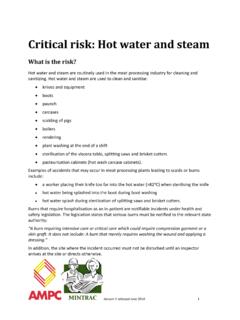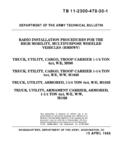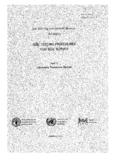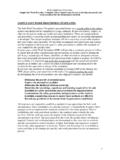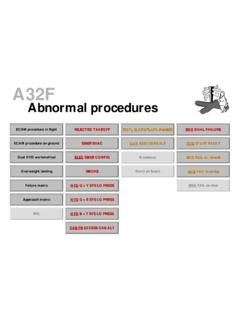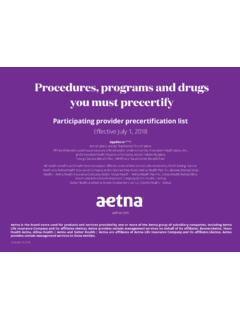Transcription of Emergency procedures - Workplace Health and Safety
1 Emergency procedures Definition of Emergency An Emergency is an abnormal and dangerous situation needing prompt action to control, correct and return to a safe condition. Types of Emergency Potential emergencies in the meat industry include fire, explosion, structural damage, power or equipment failure, refrigerant or gas leakage and confined space mishaps. Emergency plan The goal of the Emergency plan is to ensure the Safety of all occupants of the affected area and minimise damage to assests. The Emergency plan usually describes: a) Emergency procedures , including: an effective response to an Emergency evacuation procedures identifying those that hold responsibility Wardens, First Aid officers notification of Emergency services at the earliest opportunity medical treatment and assistance; and effective communication between the person authorised by the person conducting the business or undertaking to coordinate the Emergency response and all persons at the Workplace .
2 B) testing of the Emergency procedures , including frequency c) information, training and instruction to relevant workers in relation to implementing the Emergency procedures . What is the supervisor's role in an Emergency situation? The supervisor should: have knowledge of the Emergency procedures for the site, and the application to his or her area of responsibility ensure all workers under their supervision are aware of the procedures , including early warning and evacuation ensure all workers are aware of who the wardens and first aid officers are ensure all workers have been trained and have practiced Emergency procedures ensure maintenance of all equipment including fire extinguishers, warning systems.
3 Emergency lighting and exits be trained in the use of Emergency equipment such as a fire extinguisher. Image of an Emergency plan on site MINTRAC. Further information AMIC OH&S and Workers Compensation database Emergency procedures Safe Work Australia Emergency plans fact sheet tions/Documents/657 Australian Government ComCare - Emergency procedures es Workplace Standards Tasmania Emergency procedures checklist Sample Emergency policy <Site Name>. <Site Address>. <Site Phone number>. Emergency PLAN. DATE. Introduction This plan has been prepared to present the Emergency plan for the <Site Name>.
4 Its primary objective is to ensure employees know how to react in an Emergency situation on the site. That is, they are aware of what is expected of them and where they are expected to evacuate to. The Emergency procedures described in this manual have been prepared to comply with: Australian Standard AS3745. <Site Name> WHS Manual The recommended organisation and procedures in this plan provide a flexible and appropriate response in the event of an Emergency on the <SITE NAME> site. Ongoing training is needed for all employees to ensure the effective implementation of this plan.
5 The following examples of emergencies and hazards referenced in AS 3745 - 2002 Emergency Control Organisation and procedures for Buildings, Structures and Workplaces have been considered: a. Blackouts Covered in this Plan b. Bomb Threat Covered in this Plan c. Chemical Covered in this Plan d. Biological No plan as the risk is considered minimal e. Radiation This is covered through section 27 of the WHS manual f. Civil disorder No plan as the risk is considered minimal g. Cyclones (inc storm surge) Covered in this Plan h. Earthquake No plan as the risk is considered minimal i.
6 Fire Covered in this Plan j. Flood Covered in this Plan k. Hazardous substances instances Covered in this Plan l. Industrial accident Covered in this Plan m. Letter bomb/Infected letter No plan as the risk is considered minimal n. Medical Emergency Covered in WHS Manual o. Severe weather/ storm damage Covered in this plan p. Structural instability No plan as the risk is considered minimal q. Terrorism No plan as the risk is considered minimal r. Transport accident No plan as the risk is considered minimal s. Toxic emissions Covered in this Plan Table of Contents Emergency Services & Contact Telephone Media Contact.
7 9. General Evacuation 9. Emergency Planning Committee .. 11. Emergency Control Organisation .. 11. Emergency Control Organisation 12. Welfare .. 12. Stand Down procedures .. 12. Communication .. 12. Testing of Emergency Response Scenarios .. 12. De-Briefing.. 13. Training and Instruction .. 13. Records .. 13. Attachments - Site Plans 11 04 (A) Site plan - Evacuation Routes and Emergency Assembly Areas 11 04 (B) Site plan - Fire Equipment Attachments - Responsibilities 11 04 (C) Chief Warden Responsibilities 11 04 (D) Warden Responsibilities 11 04 (E) WHS Officer Responsibilities 11 04 (F) Emergency Controller Responsibilities 11 04 (G) Security Guard Responsibilities 11 04 (H) Switchboard Operator Responsibilities Attachments - Emergency Response procedures 11 04 (I) Ammonia Leak Response 11 04 (J) Chemical Leak Response 11 04 (K)
8 Black Out Response 11 04 (L) Bomb Threat Response 11 04 (M) Critical Response Procedure 11 04 (N) Evacuation After Hours Response 11 04 (O) Fire First Response 11 04 (P) Floods Response 11 04 (Q) LPG Leak Response 11 04 (R) Letter Bomb Response 11 04 (S) Severe Weather Response Other Attachments - 11 04 (T) Observer's checklist and Debriefing Record Emergency Services & Contact Telephone Numbers Contact Body Name Phone Ext /Radio Fire / Police / Ambulance 000. Alternative Numbers: Fire: Police: Hospital Poison Information Line Site Security Reception CEO.
9 Group Operations Manager Area Wardens Warden Deputy Warden Issues / Media Control WHS Officer Ammonia (Orica Australia) 1800 033 111. Liquid Nitrogen (Boc) 1800 653 272. Liquid CO2. Natural Gas (Origin Energy) 1800 808 526. Immediate Neighbours Company Name Media Contact In the event of an Emergency , the Chief Executive may only make Press Statements on behalf of <SITE NAME>. Administration staff is to be advised to respond to any queries with: ( Good morning/afternoon, <SITE NAME> we have NO COMMENT - a statement will be issued shortly.)
10 General Evacuation procedures Instructions applicable to all Occupants. The Evacuation Alarm System is a <Describe> -tone alarm system. ALERT TONE Repeated beeps. EVACUATION TONE A wailing tone. FOLLOW INSTRUCTIONS OF YOUR SUPERVISOR. The Fire and Emergency evacuation alarm system installed throughout the <Site name> Site is controlled by MANUAL CONTROL POINTS ( 'S), in the following locations: Every person should familiarise themselves with the locations of MANUAL CONTROL POINTS. ( 'S) and of Fire Extinguishers within their respective departments.




